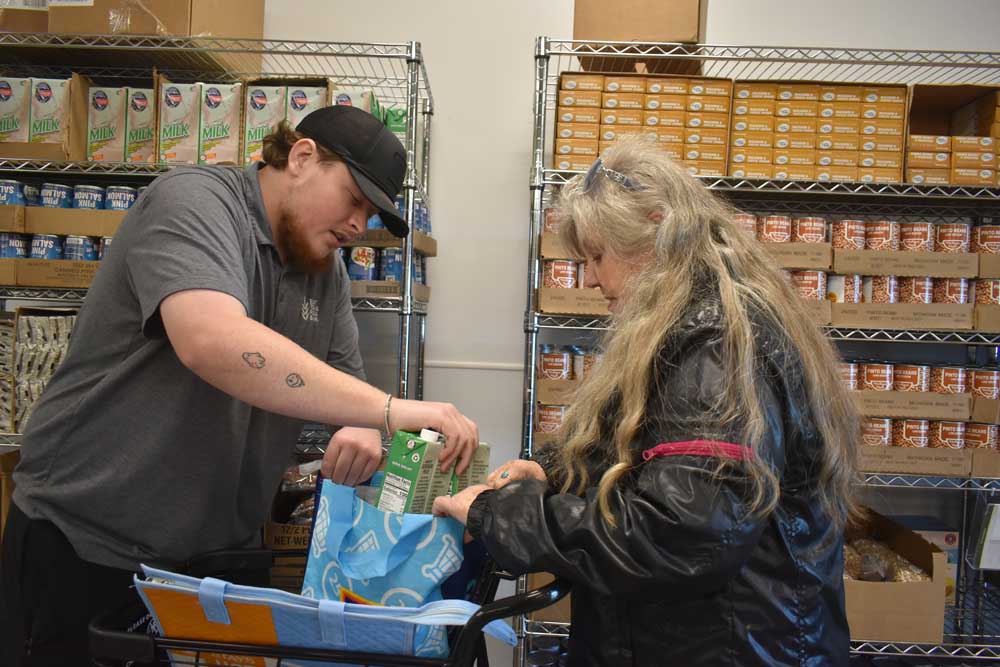East Texas Food Bank says Big Beautiful Bill could cut assistance, strain food pantries
Published 5:45 am Monday, July 14, 2025

- Tyler resident Mary Hoff, 77, comes to the East Texas Food Bank Tyler Resource Center for the fresh produce and meat. (Tyler Morning Telegraph)
The leader of the East Texas Food Bank says the federal Big Beautiful Bill Act could cause thousands of people in the region to lose vital assistance purchasing food.
The law includes several reforms for the Supplemental Nutrition Assistance Program, better known as SNAP, that food bank leaders say could cause people to lose federal benefits and turn to food banks for help — though those assistance organizations already are struggling.
President Donald Trump signed the bill into law July 4.
Trending
The act doesn’t make an outright reduction in the amount of food benefits people will receive. Rather, it restricts future food benefit increases, requires additional recipients to work and requires certain states to help pay the cost of the program.
The law is expected to reduce federal nutrition assistance spending by $186 billion through 2034, food bank officials said.
“The cuts to SNAP will be tough on our local economy, and we’ll certainly feel the impact here at the East Texas Food Bank, plus our partner agencies in the 26 counties we serve,” said David Emerson, CEO of the Tyler-based food bank.
The East Texas Food Bank serves Smith and 25 other counties in the region.
About the reforms
Almost 3.2 million Texans, about 10% of the state’s population, receive SNAP benefits, according to the left-leaning Center on Budget and Policy Priorities. The average SNAP benefit per person in 2024 was $188 per month.
It’s essential to thousands of East Texans, as roughly one in five people in the region — about 235,000 — face food insecurity, Emerson said.
Trending
Under the new SNAP eligibility requirements, able-bodied recipients between ages 18 and 65 and parents with children older than 14 will have to work or volunteer at least 20 hours per week to receive benefits. Previously, work requirements applied to people ages 18 to 54 and parents whose children were older than 18. The act eliminates work requirement exemptions for veterans, homeless people and youth in foster homes.
The act restricts future changes to the Thrifty Food Plan, which is used to calculate people’s food benefits based on the cost of purchasing healthy meals for a family of four. People will be receiving the same food benefit while the cost of buying food increases, Emerson said.
“There is no increase in there for inflation or anything else,” he said. “We know what stuff costs today. It’s probably gonna cost more five years from now.”
The bill also requires states that have a 6% error rate in their SNAP payments — either by underpaying or overpaying recipients — to pay between 5% and 15% of the cost of the program in their states. Historically, the federal government has covered the entire cost of food benefits. States also would have to pay 75% of administrative costs, up from 50%.
Arguments for, against reforms
Republicans touted the Big Beautiful Bill as a way to trim roughly $1.2 trillion from the federal deficit in the coming years, and the legislation has been a hallmark of Trump’s presidency thus far. However, disagreements remain over whether the bill will increase or decrease the deficit, as the Congressional Budget Office estimates it could add more than $3 trillion to the deficit as a result of decreased tax revenue.
Republicans in Congress have called for SNAP reform as a way to reduce waste and abuse of taxpayer-funded safety nets.
U.S. Rep. Nathaniel Moran, R-Tyler, said in a statement in June that about 74% of able-bodied SNAP recipients aren’t working, according to research by the right-leaning Foundation for Government Accountability based on data from the U.S. Department of Agriculture.
The right-leaning Economic Policy Innovation Center in 2024 reported that 62% of able-bodied adults receiving food benefits from 2017-19 didn’t work. Meanwhile, the USDA reported that around 20% of households receiving SNAP benefits in 2022 didn’t have countable income, while 26% had countable income from employment. Other households had income from sources such as Social Security.
While Republicans have targeted non-working SNAP recipients, leaders of the left-leaning Center on Policy and Budget Priorities say that many SNAP recipients work or are looking for work, and they might participate in the program for only part of a year.
“Adults who receive SNAP often work in occupations and industries with low pay or unstable hours that cause income volatility, such as important frontline service or sales roles like cashiers, cooks, or home health aides,” leaders at the Center on Policy and Budget Priorities wrote. “Many of these jobs often lack benefits such as paid family leave — or even paid sick days — which means that a worker’s own illness or an illness in the family can lead to job loss.”
Moran said the programs were created to help people during times of need and increase their upward economic mobility, “not to foster long-term dependence on a nanny state.” He said the reforms protect the program for those who need it most.
Impact on Texas
Food bank leaders estimate Texas will have to pay $716 million per year in food benefits beginning in 2028 and $89.5 million more per year in administrative costs. State lawmakers could choose to reduce people’s food benefits, which could harm those most in need, said Celia Cole, CEO of Feeding Texas, the state association of food banks.
“Families already struggling to afford groceries, rent, and healthcare will face even greater hardship,” Cole said in a statement. “Seniors, veterans, working parents and children will be pushed further into poverty — not because they’ve done anything wrong, but because the burden of balancing the budget was placed disproportionately on those already facing the greatest challenges.”
While organizations such as the food bank are vital for people, they can’t replace the role SNAP has in people’s lives, Cole said.
“SNAP is a lifeline for millions of Texans, especially during times of crisis,” she said. “The program works because it’s federally funded and responsive to fluctuations in the economy. Offloading benefit costs to states would undermine SNAP’s ability to respond to economic downturns and natural disasters — precisely when families need help the most, and state coffers are most depleted.”
Food banks across the state have seen higher demand since the coronavirus pandemic upended the nation’s economy, food bank leaders said. They’ve also been the target of other federal cost-cutting measures:
In March, East Texas Food Bank leaders were notified that the federal government had stopped shipment of roughly $750,000 in food to the organization, and the organization lost $121,000 in funding when a program to source food from local farms was cut.
Emerson said the East Texas Food Bank needs more financial support from the community as well as volunteers.
“We’re going to be here, and we’re going to feed people no matter what,” Emerson said. “We just may not be able to offer them as much or may not be able to offer them as much of a variety. Those are just decisions we have to make. I think the key thing is that the East Texas people have always been extremely generous to the east Texas Food Bank and to all nonprofits, and so we’re confident that the local communities are going to step up and help us.”
The food bank, operates the Tyler Resource Center.
People can visit the Tyler food pantry twice per month. It is open noon to 2 p.m. and 4 to 6:30 p.m. Monday through Thursday. It also is open noon to 2 p.m. Friday. For information, visit easttexasfoodbank.org/tyler/.
To learn more about the East Texas Food Bank, volunteer or donate, visit easttexasfoodbank.org/.






